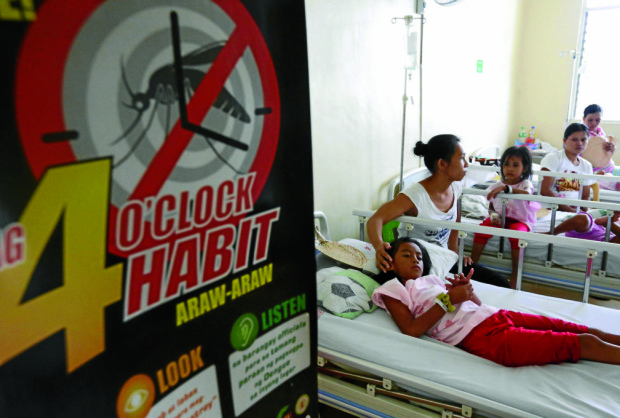Dengue cases rise by 36% nationwide, says DOH

DENGUE ON THE RISE Children stricken with dengue and their parents rest at San Lazaro Hospital in Manila. The Department of Health has added dengue to its Code White alert list as dengue cases across the country hit more than 57,000 from January to June. A Code White alert means all hospital staff are on standby round the clock and medicines and other supplies have been
prepositioned. INQUIRER FILE PHOTO
For 39-year-old housewife Maribel, the rainy season used to bring happy memories of her childhood as she and her siblings would frolic in the heavy downpour.
But not anymore. Not since a year ago when she almost lost her 8-year-old daughter to dengue hemorrhagic fever, the more severe form of dengue fever, a viral infection transmitted by the Aedes aegypti mosquito.
“I had no idea it was that bad. I thought she was just having a flu because she was complaining of headache, she had fever. But it took a few days before we took her to the hospital,” she said.
“The doctor said that her blood platelet count dropped to dangerously low levels and she was at risk of bleeding complications and even death,” recalled the mother of two from Makati City.
Nowadays, the rain makes her paranoid because their place easily gets flooded and she knows the risk it brings to her children.
Article continues after this advertisementNow the mosquito-borne disease is on the rise and the Department of Health (DOH) is reminding the public that dengue is no longer a “rainy season disease” as cases are being reported nationwide throughout the year.
Article continues after this advertisementCases up 36 percent
Based on the report prepared by the DOH epidemiology bureau, there were 57,026 dengue cases recorded nationwide from Jan. 1 to June 25, or 35.7 percent higher than the 42,026 cases recorded during the same period last year.
There was also a higher number of dengue deaths in 2016, with 248 compared with 148 in 2015 during the same period.
Based on its latest report, the DOH noted that the regions with the most number of dengue cases during the six-month period were Calabarzon with 7,463 (13.1 percent); Central Visayas, 5,783 (10.1 percent); Central Luzon, 5,586 (9.8 percent); northern Mindanao, 5,521 (9.7 percent); and Socssksargen, 4,583 (8 percent).
Vaccines
Calabarzon, Central Visayas and Central Luzon accounted for the highest number of dengue cases in the country despite the introduction of the dengue vaccines to public elementary school students in these regions.
Earlier, Grade 4 pupils aged 9 years old and above in public elementary schools in Calabarzon, Central Visayas, Central Luzon, as well as in Metro Manila, were identified as beneficiaries of the Dengue School-Based Immunization program of the DOH that started in April.
Through the program, the DOH began the administration of dengue vaccines to students in three doses, with the first one given between April and June.
Eastern Visayas
Found to have the biggest increase in dengue cases were Eastern Visayas with a 206-percent increase from 610 last year to 1,870 this year; followed by Davao region with a 138-percent increase from 1,679 to 4,002; and Central Visayas with a 137-percent increase from 2,432 to 5,783.
A declining number of dengue cases was noted in Cagayan Valley that saw a 43-percent drop from 2,664 in 2015 to 1,523 this year; and Metro Manila from 4,964 cases to 4,179.